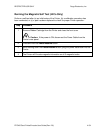RESTRICTED USE ONLY Fargo Electronics, Inc.
DTC400 Card Printer/Encoder User Guide (Rev. 2.6)
5-3
Network Services - Overview
The Ethernet option provides the services described in this section. (Note: Other additional
services include a Ping client, address assignment and Printer discovery functions.)
Reviewing the Print Server
The Print Server provides printing services in the same manner as a printer connected
directly to a USB interface except that the Printer is connected through the local area
network to the client PC. The Print Server must be properly configured in order to provide
this printing capability.
• The Print Server is capable of queuing up to eight (8) client PCs while printing.
Communications between each PC and the Ethernet-enabled Fargo Printer are
implemented over a bi-directional TCP/IP interface.
• All clients are able to send print jobs to the Printer and monitor Printer jobs and errors
with the standard Windows printing system using the Fargo Printer Driver installed on
their local PC.
In this way, the User knows whether or not a print job has been successful. Also, the User
knows what problems have been encountered while processing the print job. Printing using
Ethernet works in a manner similar to the USB-connected PC/printer.
Reviewing the Web Page Server
An HTTP service serves web pages that provide an interface through which to configure and
monitor the Printer. (Note: Users may also monitor all print jobs that have been sent to the
Printer from any client PC.)
Reviewing the Network Management Interface
The Ethernet-enabled Printer operates as an SNMP agent to allow central administrators to
monitor and configure the network interface and the Printer. (Note: A standard host MIB-II is
implemented to maximize the utility of the Printer on the network.)
Reviewing the Telnet Server
The Ethernet interface has a command line interpreter. (Note: The User can connect to the
Printer using a Telnet session on their PC, issue commands to the Printer and receive
response from the Printer.)
The Telnet commands are primarily used for network administration, and they will not be
used by most Users. (Note: These commands will query the state of the Printer and
configure various settings for the Printer. These include network settings, logging setting,
User names and User passwords.)


















